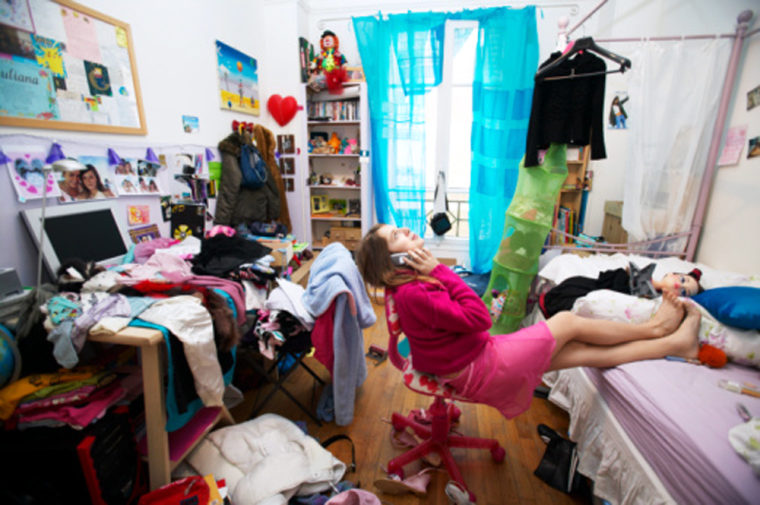You may intuitively recognize those dirty clothes scattered across your bedroom floor or the piles of papers burying your desktop as a total mess, but scientists have now figured out a way to measure just how cluttered your room or cubicle really is.
Although the research is still a work in progress, future mess-o-meters could lead to better Web designs, improved navigation systems and even smart cars that warn when an overly cluttered street scene may create a dangerous situation.
“For the first time, really, we have some promising measures of visual clutter which can tell you the amount of clutter in any image you give it,” said Ruth Rosenholtz, a researcher in the Department of Brain and Cognitive Sciences at Massachusetts Institute of Technology.
People tend to have somewhat different gut-level reactions to what constitutes clutter, and those intuitions are often unreliable indicators of how well the brain can pick out a “You are Here” symbol in a display, research suggests. In contrast, Rosenholtz said that the measures of messiness developed by her research team correlated well with how volunteers did at tasks like finding an arrow on increasingly busy maps.
Visual clutter, according to Rosenholtz and colleagues in the latest issue of the Journal of Vision, can likewise interfere with real-world tasks such as searching for potential threats in checked-in luggage or recognizing a pedestrian while driving. The challenge may be fun when playing “Where’s Waldo?” but not so entertaining when sifting through mounds of paperwork for an important insurance document.
No one’s yet suggesting an audible alarm for when your desk becomes unrecognizable. But with an improved understanding of what contributes to the problem and a reliable gauge of factors such as contrast, color, orientation, organization and motion, clutter-measuring programs could lend a hand to professional and amateur designers alike.
The study suggests that simply counting the items in a display, as past efforts have done, is an inadequate measure of clutter. On a weather map, for instance, does a single raindrop or a state’s outline constitute one item, or several? Natural scenes only compound that uncertainty, said study co-author Yuanzhen Li, a graduate student in Rosenholtz’s lab.
In attempting a more concrete appraisal, the researchers tested three computer programs. The first, called Feature Congestion, “is based on the experience I think we all have of trying to leave a note on someone’s desk,” Rosenholtz said. “If the desk is cluttered, it’s hard to leave a note which we’re confident they’ll notice.” The measure, in effect, relies on a statistical model quantifying how difficult it would be to add an attention-grabbing sticky note to a display such as the desk or a computer screen.
A second model, called Subband Entropy, can be thought of in broad terms as the “Why haven’t you cleaned your room yet?” measure of clutter. Much like an exasperated mom, the model assumes that the more words needed to describe the entropy of a teenager’s bedroom floor, the more cluttered it is. “If you just have ‘Carpet, carpet, carpet, dirty sock,’ then it’s just two words,” Li said. But throw in a laptop, pizza boxes and forgotten homework and the scene requires more explanation. By the model’s definition, not to mention a mother’s, it is also more cluttered.
The final model, known as Edge Density, uses an off-the-shelf software application based on the simple but difficult-to-define notion that more objects mean more clutter. In this case, a tally of the objects’ edges becomes a proxy for the number of scene-clogging objects.
All three of the measures performed well in predicting how quickly volunteers could determine that symbols were present or absent in variously cluttered maps. The Feature Congestion measure, however, outperformed the others in capturing the contributions of color variability, which the study suggested can be an important factor in visual clutter.
“This is something designers know well,” Rosenholtz said. “There’s a trade-off between putting more colors in your display, which can give you more information, and using fewer colors, which is less cluttered and often more soothing. Do you represent each symbol in a map with a different color, which can help distinguish them, or make them all similar colors, which is less cluttered but also less informative?”
Mary J. Bravo, an associate professor of psychology at Rutgers University in Camden, N.J., said she admired Rosenholtz for tackling the tough but worthy problem of quantifying clutter. “I think the project is very important,” Bravo said, “and I think she’s the right person to do it.”
Although the new MIT-produced models are not “amazingly better” than past measures, Bravo said the research has potential. To be broadly applicable, future models may need to take into account real-world decisions based on prior experience (people usually stick important notes to my computer screen instead of my desk). Another obstacle, according to Bravo, will be in separating relevant display information from its irrelevant background. On a city map, for instance, the name of a neighborhood may be important to one pedestrian, while another may ignore it in his search for the name of a main thoroughfare.
Whether a future version will ultimately end up in the hands of experienced design teams or amateur presenters, Rosenholtz said the Feature Congestion measure has shown that it’s possible to map out where different types of clutter are concentrated in an image.
“Clutter concentrated in one region might tell you to spread out the information more uniformly,” she said. “A lack of color clutter might tell you that if you really want to draw attention to an ‘alert,’ you could do so just by using a distinct color, instead of having to annoy your user by flashing a light at them or something like that.”
Web surfers everywhere could likely agree on the benefit of that.
